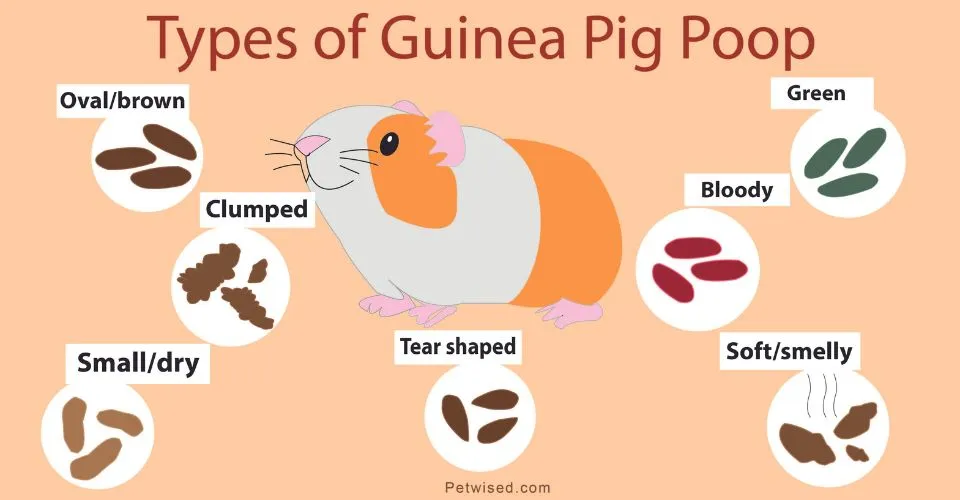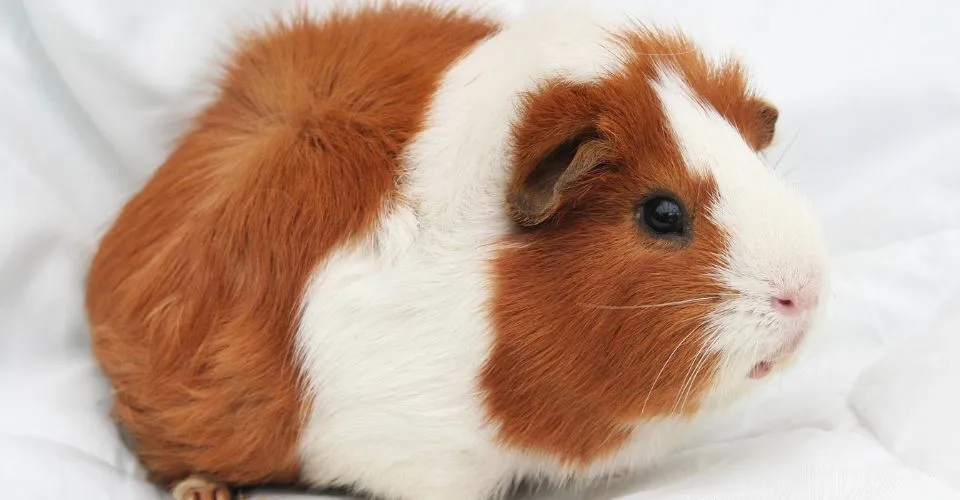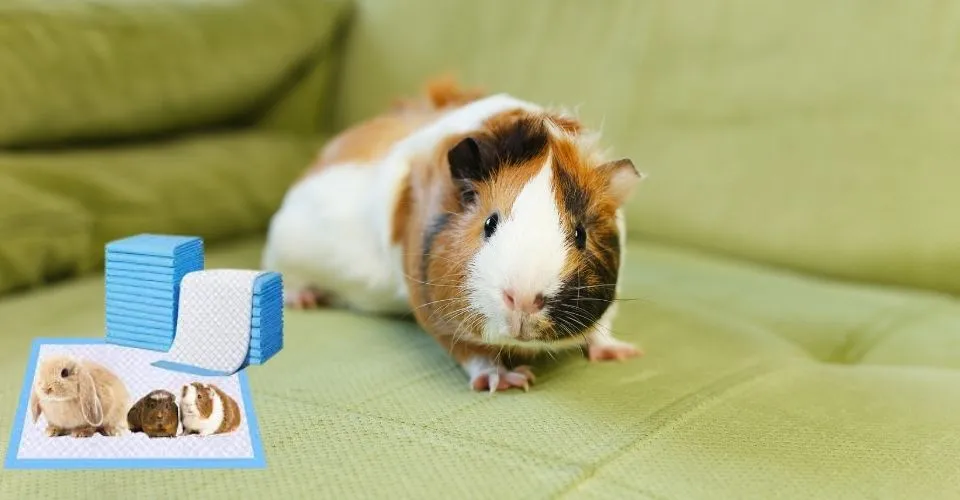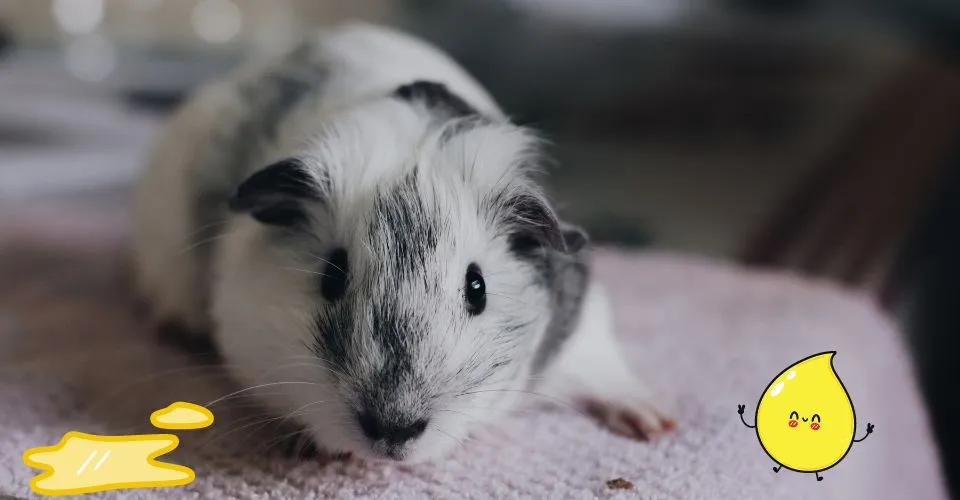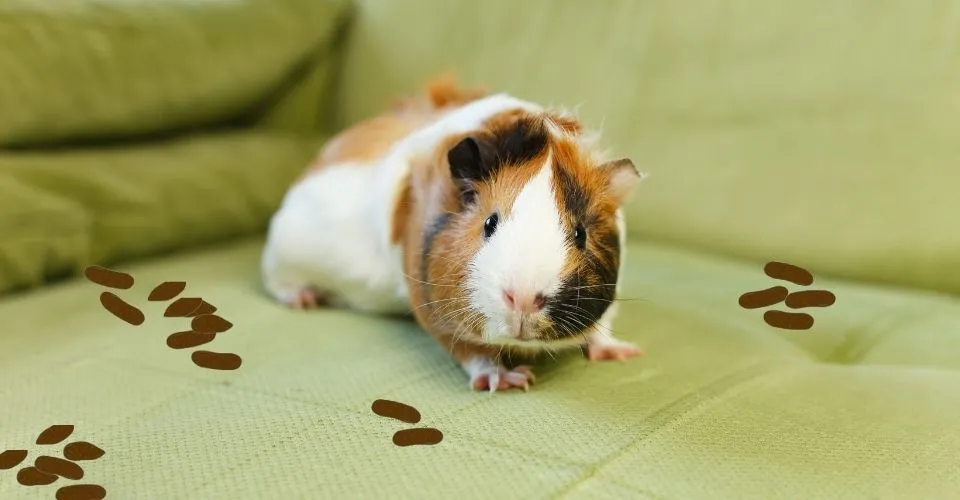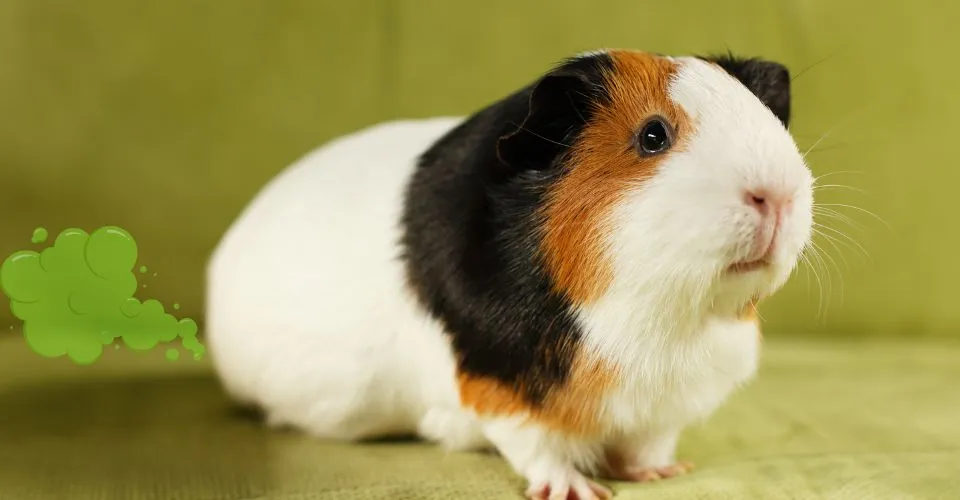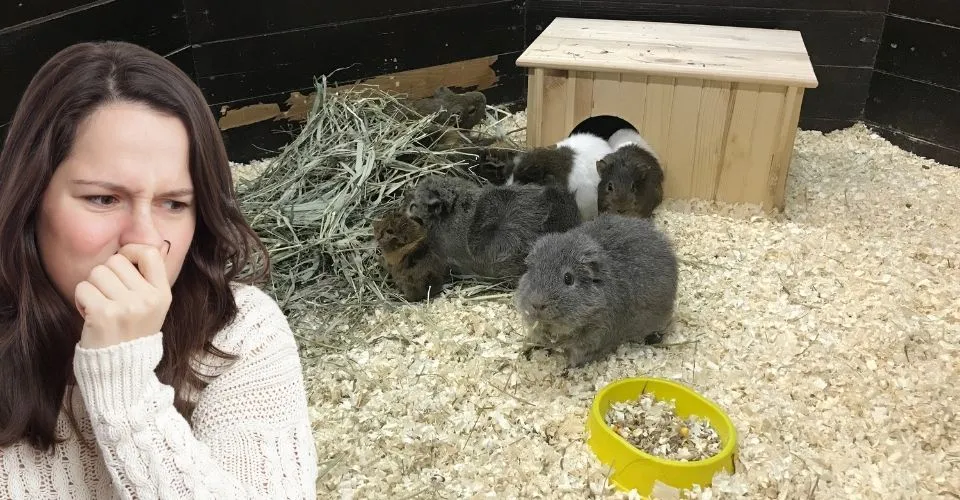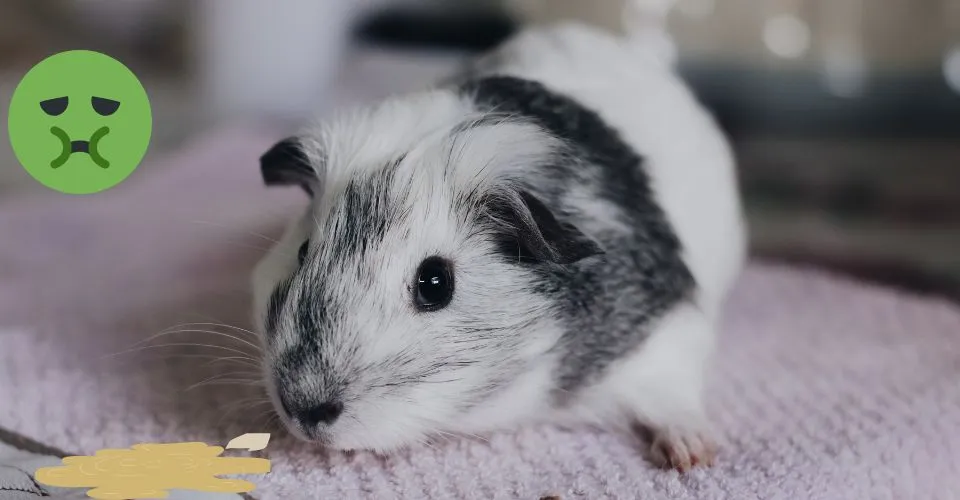We all poop. Every animal poops. So do our guinea pigs. They just happen to do it a lot more!
While most novice owners do not like to talk about guinea pig poop, you should know that it is absolutely necessary for every guinea pig owner, especially novice owners. Knowing how to read a guinea pig poo is crucial for guinea pig owners to keep their piglets healthy and happy.
You are probably thinking that your guinea pig (who is often eating its own poop) and I (talking about reading guinea pig poo) have completely lost it. Well, you are not alone; all first-time owners say the exact thing until they find out that the poop pellets that their piglet is eating are nutritious and are not really poop and that their piglet’s poop has a lot to say about their overall health and well-being.
Why Do Guinea Pigs Eat Their Poop? is a topic for another post. In this article, we are going to discuss about different types of guinea pig poops and what they have to tell us about their health.
Guinea Pig Poop Types With Meaning
Guinea pig’s poop changes in size, texture, shape, color, and odor depending on its gut and overall health. Therefore, it is crucial that guinea pig owners know what a healthy guinea pig poop should look like so they can tell the difference if their guinea pig is sick and pooped differently. Guinea pigs are stoic little creatures and tend to hide their signs of sickness, therefore, owners need to be vigilant. If you keep a check on your piggies’ poop, you can tell if they are experiencing any health issues by the type of their poop. Similarly, the guinea pig’s pee color would also allow owners to get an idea about the overall health of the guinea pig.
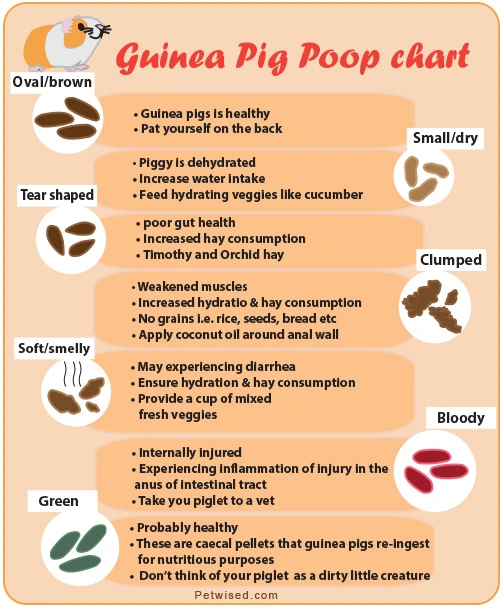
| Poop Type | Meaning | Cause | Action |
| Oval-shaped, brown poop with no smell and uniform consistency | Guinea pig is healthy | Piggy is happy and eating a balanced diet | · Pat yourself on the back |
| Guinea pig small poop and dry | Guinea pig is dehydrated | Piggy is not drinking enough water | · Increase water intake · Feed hydrating veggies like cucumber |
| Guinea pig pointy poop, tear-shaped poop | Guinea pig has poor gut health | Piglet is not consuming enough hay | · Increased hay consumption · Offer both Timothy and Orchid hay · Sprinkle Favorite treats on Hay |
| Clumped guinea pig poop, stuck together | Guinea pig muscles have weakened | Guinea pig has grown old or is not consuming enough hay and water | · Increased hay consumption · Increased hydration · No grains including rice, seeds, bread, etc. · Apply coconut oil or petroleum jelly around the anal wall |
| Guinea pig soft poop, smelly and mushy | The Guinea pig is sick | Either the guinea pig is not getting a balanced diet, or he is experiencing diarrhea | · Ensure your piglet is hydrated · Increase hay consumption · Provide a cup of mixed fresh veggies |
| Blood in guinea Pig poop | Guinea pig is internally injured | Might be nothing, it is just pigmentation from beetroot or cranberry juice It could be a sign that the guinea pig is experiencing inflammation or injury in the anus or intestinal tract | · Take your piglet to a vet without wasting any time |
| Guinea pig green poop | Guinea pig is probably healthy | These are caecal pellets that guinea pigs re-ingest for nutritious purposes | ·Just don’t think of your piglet as a dirty little creature |
1. Healthy Guinea Pig Poop
Healthy guinea pig poop is oval-shaped and brown to black and surprisingly has no smell. It should have uniform consistency; neither it should be too dry, nor it should break into pieces when piglets step on them. It is completely normal for healthy guinea pig poop to have a little bit of grainy texture due to all the hay they are munching all the time.
The healthy guinea pig poop should be about smooth (a bit grainy is normal as well), plump, and well-rounded at both ends. While the guinea pig poop size varies from piglet to piglet, the average guinea pig poop size is around 1 cm in length. Point or tear-shaped poop is a sign that something is wrong with your guinea pig. Keep in mind that adult males’ poop could be up to 1.5cm and even 2cm in length.
What Does Healthy Guinea Pig Poop Look Like? • Medium to dark brown in color • Oval-shaped and uniform in consistency • Neither dry nor too moist that they break into pieces when piglet steps on them • There should be no smell • Little grainy texture due to hay they eat is normal
Guinea Pig Small Poop And Dry—Dehydration
If guinea pig poop size is smaller than the average size and poop pellets are dry even immediately as they are dropped out, your guinea pig is dehydrated.
Guinea Pig Dehydration
Guinea pig dehydration is serious and should be dealt with right away. Otherwise. The piglets may develop life-threatening situations. Guinea pigs are supposed to eat around 10% of their body weight. On average a guinea pig should drink around 80 to 100mls of water every day. If you have a lactating piglet on your hands, you should be drinking even more water.
Signs of Guinea Pig Dehydration • Dry and small poop • Loss of appetite • Dark-colored urine • Thick ad sticky saliva • Crusty eyes • Fever
How Long Can Guinea Pigs Go Without Water?
Depending on their health, guinea pigs can go up to 24 hours without water. After 24 hours a guinea pig would start exhibiting the above-mentioned signs of dehydration. Dehydration if not addressed immediately could do some permanent or temporary damage to guinea pigs’ health.
What Can You Do When Guinea Pig Poop is Dry And Small? Increase the water intake of your guinea pig. You can do this by ensuring that your guinea pigs know how to drink from the water bottle that you just installed in their cage. You can click on the nozzle and show it to them. Make sure that your piglets try the water bottle. If you have placed a water bowl in a guinea pig cage, ensure that it is filled with fresh and clean water. If there is a guinea pig poop pellet in the bowl, clean the bowl and pour fresh water in it. Guinea pigs are clean creatures and would not even go near contaminated water. You can also add watery veggies like cucumber to your piglet’s diet. Keep in mind that cucumber is brimming with water, which will hydrate them, but it is devoid of many other essential nutrients. As a general rule of thumb, you should never feed more than one cup of mixed veggies to your piglet in a day.
Guinea Pig Pointy Poop (Dry And Tear-Shaped)—Unhealthy Gut
If your piglet is dropping pointy tear-shaped poop pellets, it could mean that your little friend is experiencing some gut problem. This usually happens when guinea pigs are not eating enough timothy hay. The hay provided essential dietary fibers to guinea pigs, which is crucial for gut health. So when guinea pigs stop munching on their hay, the functioning of their digestive systems is disturbed.
Guinea pigs not eating hay could also lead to dental issues. Guinea pig teeth are continuously growing and the consumption of hay allows guinea pigs to keep a check on the teeth’ growth by wearing them down.
What Can You Do When Guinea Pig Poop is Pointy And Tear-Shaped? • You can increase your piglet’s hay consumption by ensuring that they always have access to fresh and quality hay. • Instead of putting the hay on the ground or in a bowl, you can put it in a hay feeder. • If you have a picky eater, you can offer both Orchid (sweeter and aromatic) and Timothy hay. • Add guinea treats on top of hay to encourage eating.
Guinea Pig Clumped Poop—Guinea Pig Impaction or Constipation
Is your guinea pig poop stuck together? Is your guinea pig not pooping as much? Does your guinea pig squeak when pooping? While it may look like a guinea pig is constipated, know that guinea pigs don’t really experience constipation.
It could mean that your boar is getting old, and its rectal muscles are weakening. It is becoming impossible for your guinea pig to push out the caecotrophs—guinea pig poop pellets containing the unabsorbed nutrients (guinea pigs eating poop are actually eating these nutritious pellets).
Suffering from impaction, guinea pigs may experience difficulty pooping. In such conditions, the guinea pig may try to poop but nothing comes out. Guinea pigs poop a lot. So, if your guinea pig is not dropping enough poop pellets, you should observe him carefully.
While you can help your constipated guinea pig at home, it is strongly advised that if the state of constipation persists over 24 hours, you take your piglet to a vet who is experienced with guinea pigs.
What Can You Do When Guinea Pig Poop is Clumped or stuck together? • Make sure that your guinea pig is consuming hay in abundance. • Keep your piglet hydrated by encouraging drinking and by offering hydrating veggies like cucumber. • Avoid feeding grains to your guinea pig. This would mean no rice, bread, or seeds for the piggy. • Encourage your guinea pig to exercise more often. • Apply coconut oil or petroleum jelly around anal wall.
Guinea Pig Soft Poop, Smelly, And Mushy—Imbalanced Diet or Diarrhea
Guinea pigs’ soft and mushy poop indicates guinea pig diarrhea. Overly wet and smelly poop could also mean that your guinea pig is not eating a balanced diet. Guinea pig diarrhea is not to be taken lightly. If left unattended, it could be deleterious for your piglet’s health and in severe cases can even cause death. So, if you observe the following signs of diarrhea in your guinea pig, immediately consult a veterinarian:
- Watery stool
- Dehydration
- Poor appetite
- Lethargy
- Drop in body temperature
- Dull and depressing appearance
What Can You Do When Guinea Pig Poop is Soft and Smelly? • Make sure your guinea pig is hydrated. Encourage him to drink more water. Offer diluted cranberry juice. Feed him hydrating veggies like cucumber. • Provide fresh hay in abundance to your guinea pig. Dietary fibers in hay are essential for guinea pig gut health. • Provide a mixed cup of fresh veggies like squash, dandelions, arugula, and collard greens, to your piglet. Be cognizant that veggies cannot replace the main guinea pig diet—hay. • Ensure there is a lot of roughage in the guinea pig diet. It is essential to decrease the chances of diarrhea in guinea pigs and for keeping guinea pig teeth growth in check.
Guinea Pig Black Poop
Many assume that normal guinea pig poop color is black but it is actually medium to dark brown. Guinea pig black poop means that your guinea pig is ingesting more than the required amount of proteins. After absorbing the required proteins, the remaining protein is excreted by guinea pigs. It would also make your guinea pig drink more water than usual and pee and poop more often. With higher protein, guinea pig pee would have a terrible smell.
What Can You Do When Guinea Pig Poop is Black? • If your piglet’s poop is black, you should work on reducing the protein content in its diet. • You will also have to increase your piggy’s water intake.
Blood in Guinea Pig Poop
If you suspect blood in guinea pig poop, instead of panicking you should first make sure that it is actually blood. Actually, the consumption of fruits like beets and strawberries could result in dark red or purple tints in guinea pig poo. But if you have not fed any fruit or veggie with red pigment to your piglet, you should take your little friend to a veterinarian without wasting any time.
Guinea pig bleeding from the anus or traces of blood in guinea pig poop could mean that your piggy friend is experiencing a mechanical blockage, tear or injury, or inflammation in the intestinal tract or the anus.
What Can You Do When There is Blood In Guinea Pig Poop? Blood in guinea pig poop or guinea pig bleeding from the anus is a guinea pig emergency. Thus if you spot even a trace of blood in guinea pig poop, you should rush your piglet to an exotic veterinarian.
Guinea Pig Green Poop
If your guinea pig is re-ingesting the green poop pellets, chances are they are nutritious caecal pellets.
Guinea pigs are actually coprophagic animals—they tend to eat their own feces to absorb the maximum nutrients from the food they eat. In fact, during the first round of digestion, guinea pigs are not able to extract and absorb all the nutrients from the food they are processing and therefore end up excreting plenty of useful nutrients in these caecal pellets. These pellets are different from the actual poop droppings and are a bit greenish and aromatic.
What Can You Do When There Is Guinea Pig Green Poop? As green poop droppings are actually nutritious caecal pellets, you can embrace yourself for witnessing your guinea pig eating its own poop. It is a perfectly normal and healthy activity, so you don’t need to do anything about this. However, you can try not to think of your piglet as a dirty little critter.
Guinea Pigs Poop: FAQs
How Often Do Guinea Pigs Poop?
Guinea pigs poop a lot—a lot, a lot. A healthy guinea pig poops at least 100 times a day. Actually, guinea pigs are munching on hay all the time, which is loaded with dietary fibers so if a piglet is not doing up to 100 droppings a day, you should get concerned. If the number of droppings is below 50, you will have to visit a veterinarian.
Why Do Guinea Pigs Poop So Much?
It is probably the high fiber content of hay that guinea pigs are munching on all day long. If your guinea pig is overeating or is a bit nervous, you can expect them to poop even more.
Why Does My Guinea Pig Squeak When Pooping?
Guinea pig squeaking when pooping is a clear sign that your guinea pig is having trouble passing the stool—it hurts to poop. Squeaking when pooping could also be a symptom of bladder stone, UTI, chronic cystitis, or just bladder pain. So, if you hear your guinea pig squeaking, you should take him to a cavy-savvy vet for a wellness check-up and rule out the possibility of stones, UTI, or any other serious underlying health issues.
